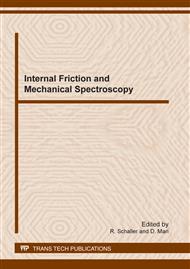p.325
p.333
p.339
p.345
p.351
p.355
p.361
p.366
p.372
Phase Transitions in Polymers for Lithium Batteries
Abstract:
The Young’s modulus and the elastic energy dissipation of polyethylene oxide (PEO)-based lithium battery electrolyte membranes have been studied in this work. The membranes, formed by pure PEO and doped by LiCF3SO3, Li2S and ZrO2, were studied within a 90 K - 400 K temperature range. We observed the glass transition around 230 K and the first-order phase transformation from the crystalline to the amorphous phase around 330 K on heating. We also measured the isothermal kinetics of the transition from the amorphous to the crystalline state and found that it is slower in doped PEO. Moreover, we showed that for both samples the transformation becomes slower as the temperature increases between 319 and 331 K. The experimental results suggest that the amorphous state is stable at 331 K for a few hours before the transformation takes place. Finally, the moisture effects on the mechanical properties of pure and doped PEO membranes are reported.
Info:
Periodical:
Pages:
351-354
Citation:
Online since:
January 2012
Authors:
Price:
Сopyright:
© 2012 Trans Tech Publications Ltd. All Rights Reserved
Share:
Citation:


